Antiquities: ThinkPad 380E, 90s Economy Class and Windows 95
Collecting old equipment may be slightly dishonest to the realities of the time you are trying to learn. Most vintage notebooks at the start of sales were either expensive (ThinkPad 600 , ThinkPad T22 ) or very expensive (ThinkPad X301 ). If in those days I weren’t carelessly poor, I probably wouldn’t buy such devices. We always try to find a compromise between price and quality, and we do not spend money on technologies that would be fun to try, but they are not necessary at all.

The laptop I’d like to talk about today is the 1997 economy class. Moderately powerful, moderately mobile, but noticeably inferior to the flagships. Last year, I bought the IBM ThinkPad 380E in pristine condition, with a live hard drive and battery. It seems that it has never been opened, and the original Windows 95 with all utilities is still installed there. Let's look at both the laptop and this first truly modern Windows. And we will decide whether its reliability corresponds to all the jokes that were told about it.
I keep a diary of a collector of old pieces of iron in real time in a Telegram . In the next couple of weeks I will share my impressions of one of the first PDAs on Windows CE - Philips Velo 1.
The IBM ThinkPad 380 notebook series was introduced in 1997. In March 1998, the lineup was updated. At least from the point of view of processors, this was a time of great progress. In my own coordinate system, even the Pentium MMX, released in 1996, seemed incredibly powerful, and in May 1997 the Pentium II was introduced, which remained relevant until the beginning of the 2000s. An update to the 1998 IBM notebook line, however, still uses Pentium MMX mobile processors with a frequency of 200 or 233 megahertz. But today we have a post ofrogue economy, so 150 megahertz will be enough. How much did laptops cost in 1997?
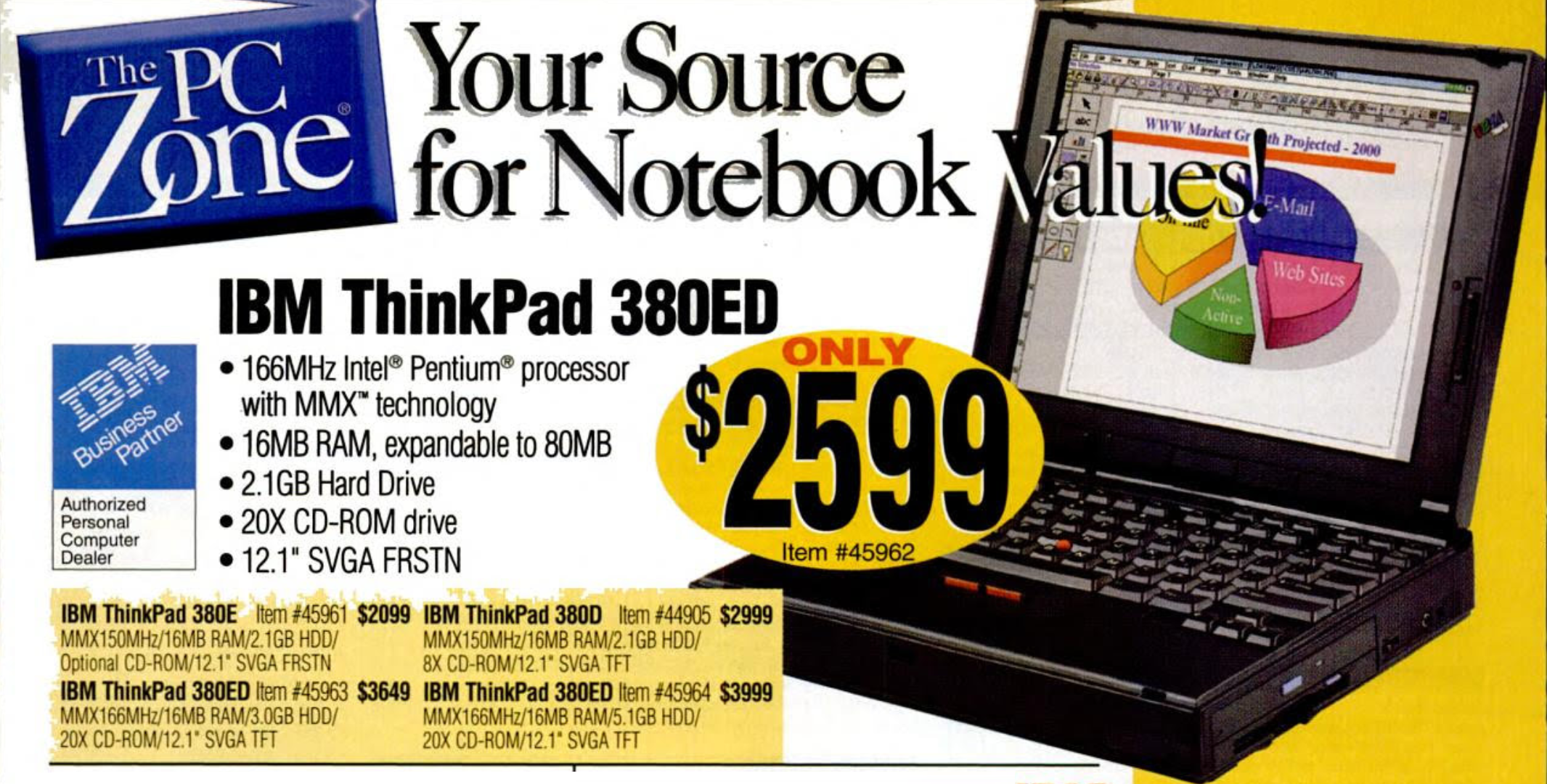
Laptops were expensive. This is an ad from PC Magazine in November 1997. Most attention is paid to the ThinkPad 380ED laptop, which started my vintage notebook hobby many years ago . In the footnote you can see the specifications and price of the hero of this article.
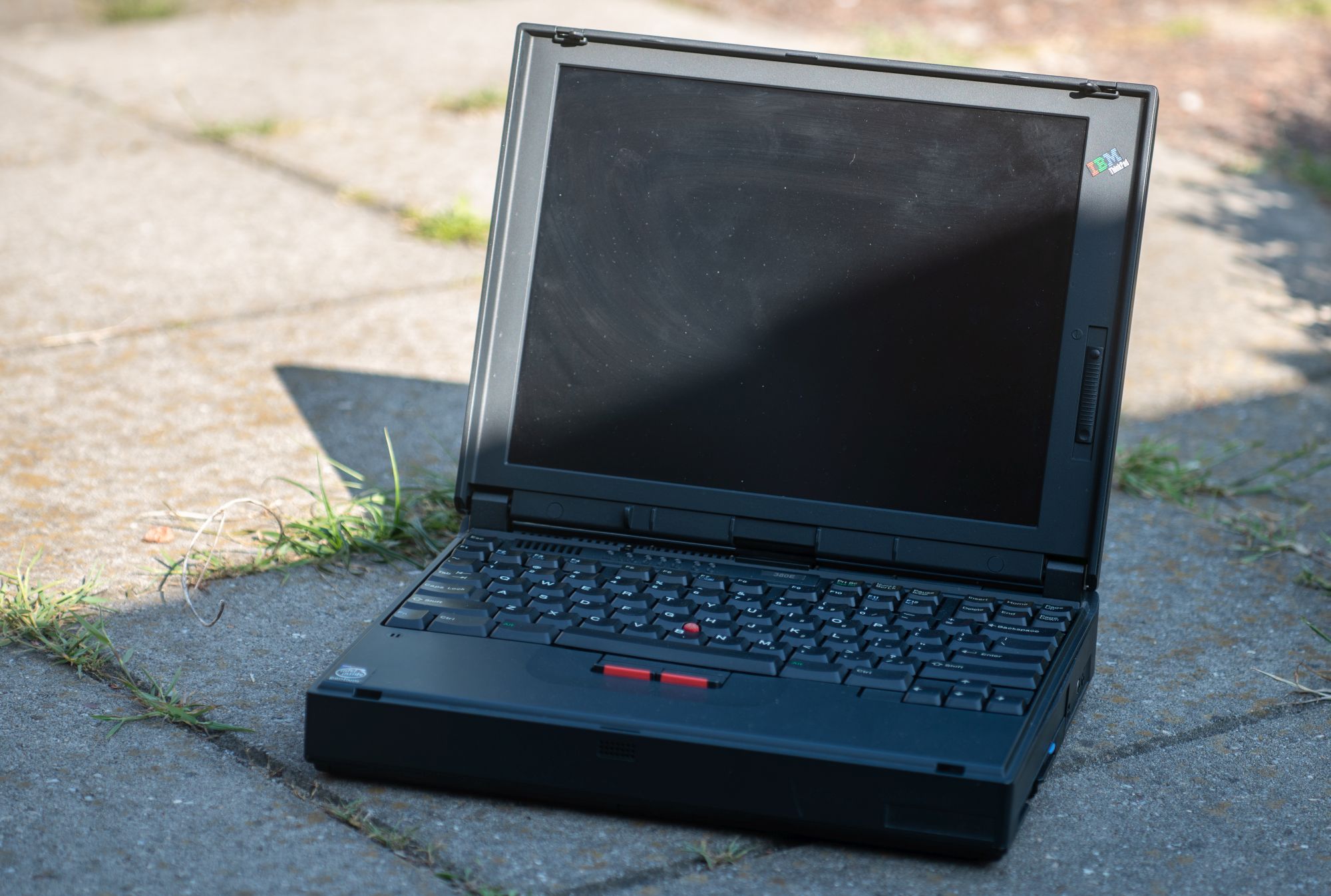
The specifications on my laptop are fully consistent with the advertising ones:
Processor : Intel Pentium MMX 150 MHz
Memory : 16 megabytes EDO SDRAM (later I increased the volume to 32 megabytes, maximum 64)
Hard disk : 2.1 gigabytes
Display : 12 inches, 800x600 pixels, technology FRSTN, 65k colors
Video card : Neomagic Magicgraph 128ZV, 1,125 megabytes of internal memory
Connectors and communication : IrDA 1.1, PCMCIA 16 bit, serial and parallel ports, VGA, port replicator
Battery : NiMH, up to two hours of battery life
Dimensions and weight: 300x233x60 mm 3 kilograms

Such a laptop in the United States cost $ 2,099, or $ 3,342, adjusted for inflation. A small upgrade that adds a CD-ROM drive and a more powerful processor to the laptop will cost $ 500. But the top-end device of the series - 380ED with a TFT matrix and a five-gigabyte hard drive - will cost $ 4,000 already (6,367 adjusted for inflation). In 2019, you can buy a very good laptop for 2-3 thousand dollars, but in those days only the budget option was available for that kind of money. Do not forget that the ThinkPad 3xx series generally consisted of entry-level portable computers. Prices for thinner fifth-series laptops and 7xx desktop substitutes were even higher: the same advertisement mentions the ThinkPad 760XD with an entry-level config for $ 4,700 (7,500 modern).

I wonder where they first came up with this 3-5-7 digital sequence to separate budget, normal and premium devices? In a BMW? Below $ 2,000, one could fall only due to an even greater deterioration in performance, or if you look towards lesser-known brands. In 1998, IBM will release a ThinkPad 310E laptop with a starting price of 1600. It will not differ much from the hero of the post, only the screen will be even worse, although it would seem to be much worse?
What can I say, it's easier to show the video.
In a review of the ThinkPad X301, the flagship of 2008, I already complained: it seems to be a good laptop and relatively suitable for modern tasks, but the display. Today we are completely spoiled by IPS-screens with huge viewing angles, and we look askance at ordinary TFTs: it is worth turning the screen a little differently, and colors begin to immediately distort. In 1997, the choice was between the newfangled and expensive TFT and cheaper displays with Super-twisted nematic technology . According to STN technology, black-and-white screens of the first laptops were made, then color ones appeared. From the usual TFT-screens (in those days they were called “active matrices”, denoting the ability to individually control the on and off of each pixel), they were distinguished by extremely high response time, low contrast and a small working viewing angle.

The ThinkPad 380E's laptop display is made using Fast Response STN technology, but this Fast translates to a passport response time of 150 milliseconds (versus 75ms in the first TFT screens). Contrast ratio is 35 to 1 (against 100 to 1 in TFT displays of the past and 1000: 1 in modern ones). Identifying a vintage laptop with a CSTN display is usually possible by the presence of two controls: in addition to the usual brightness of the display, you can adjust the contrast. The 380E does not comply with this rule: brightness is not adjustable at all, and a single slider controls contrast. This is an important regulator, it allows you to adjust the display from the state "nothing is visible at all" to "something can be read, but with difficulty." To be honest, neither color rendition nor response time cause me problems when working with a laptop. But the viewing angles are just awful.
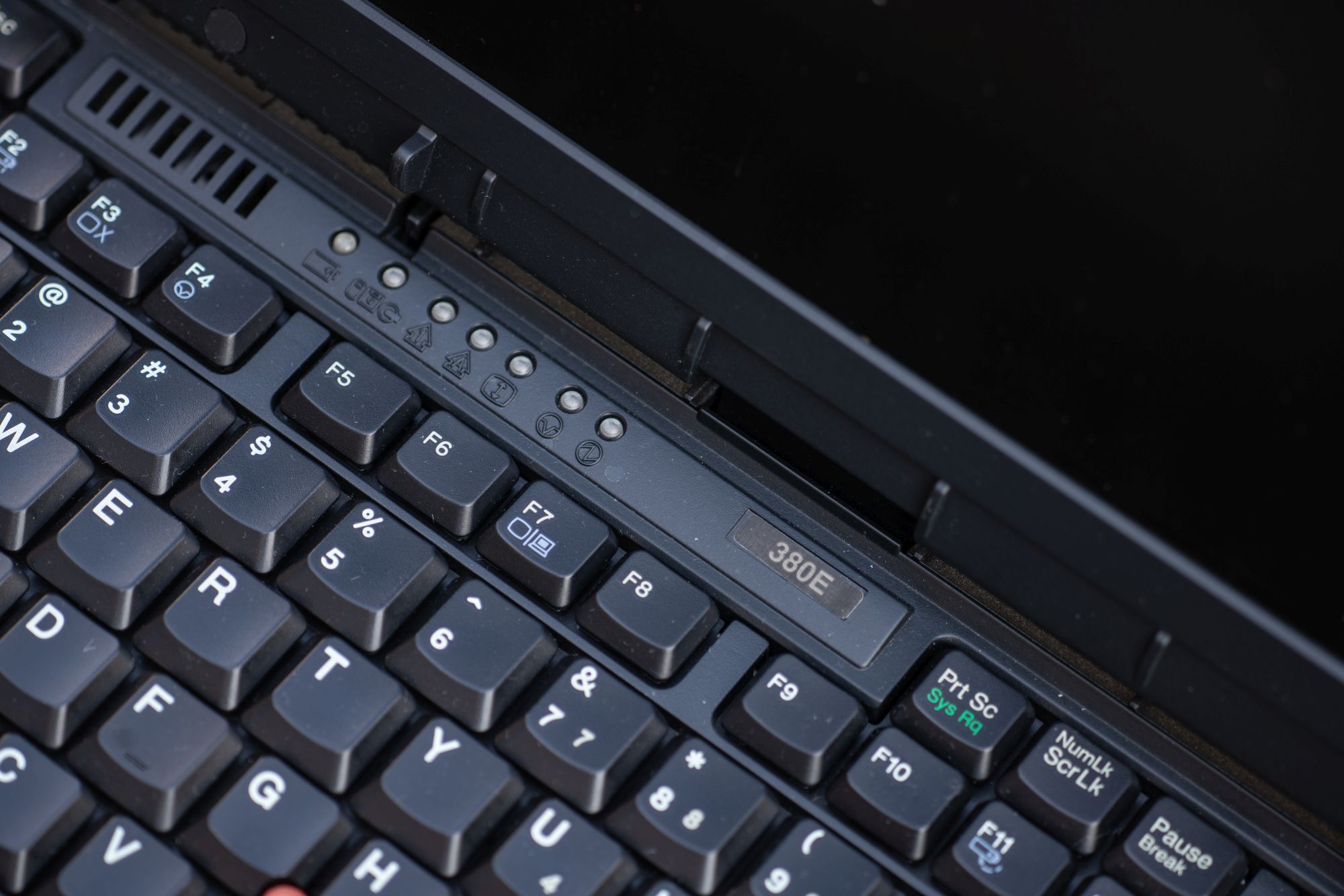
Why was a laptop needed in the late nineties? In a January 1998 PC Magazine editorial , magazine editor Michael Miller unambiguously defines the target audience: frequently traveling professionals who need access to the Internet, access to a large amount of data and the ability to work with them at any time. Only in passing is a category of people mentioned who carry a laptop only to and from work. A situation has not yet been formed in which it is easier to give a laptop to a new employee than to install a desktop with a monitor and wires. I do not think that the computer was then laid down, as it is now, in general to all employees up to the guard and secretary. Even budget models were not accessible to everyone: in 1998, I saw laptops except on store shelves and in the movies.

The 380E lacks the main element of an employee conducting a business trip for six months - the built-in modem. In general, this is the only device in my collection that I encountered with certain difficulties: I have no optical drive, no USB (it will appear a year later), how do I upload large volumes of data to it? On floppy disks? The modem, however, is added without problems by installing a PCMCIA expansion card, in the same way you can connect the laptop to a local network or add a USB flash drive. This laptop does not understand 32-bit PCMCIA cards, but I have in stock a couple of suitable old adapters. But in general, since we have before us such an intentionally limited device, it will be interesting to emulate a modem connection via a serial port.
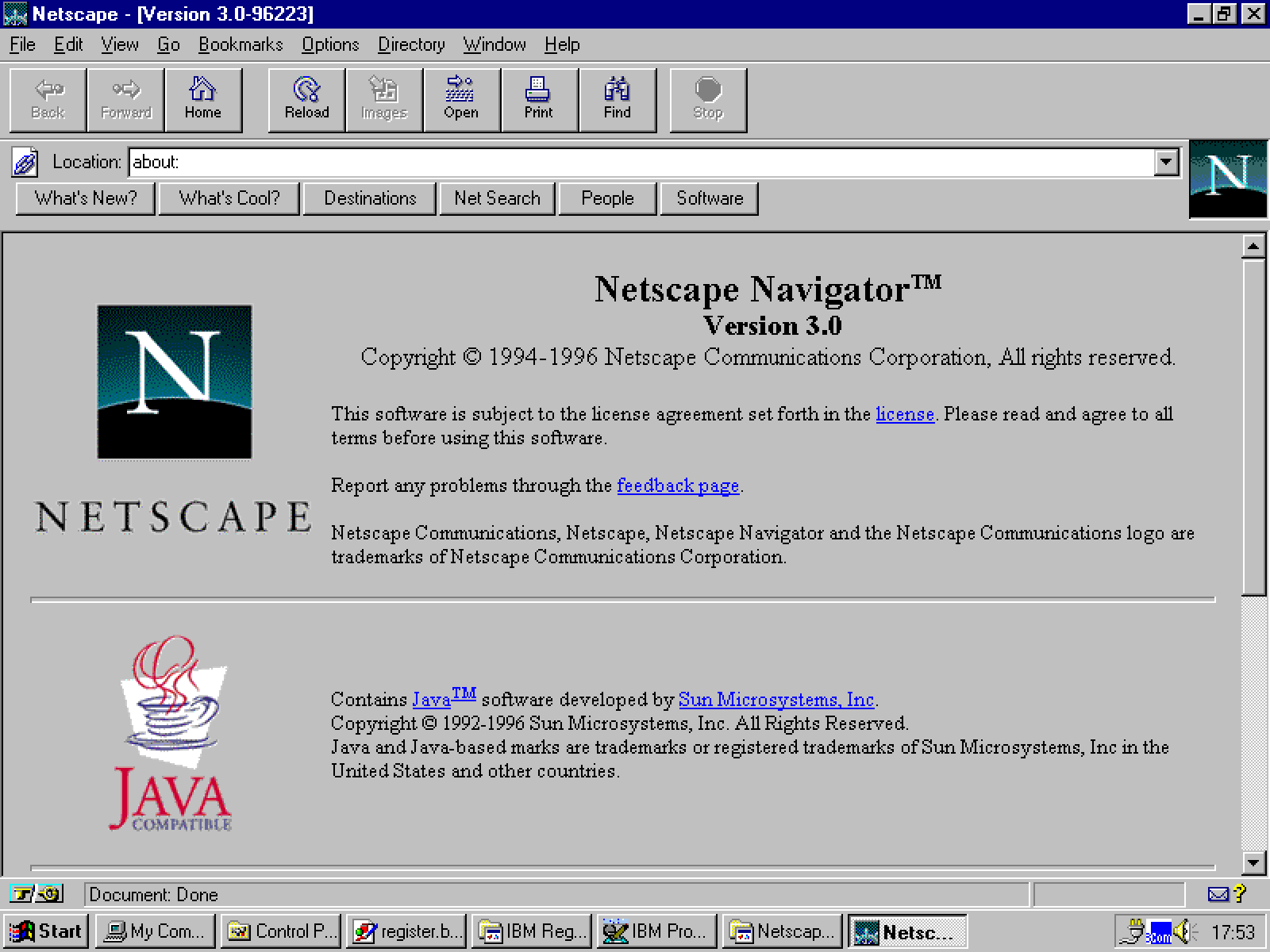
Devices on Pentium II and higher can still be tried to somehow attract to modernity, but here the situation is different - why, what's the point? I did not even make out this museum exhibit and began to study the installed software.
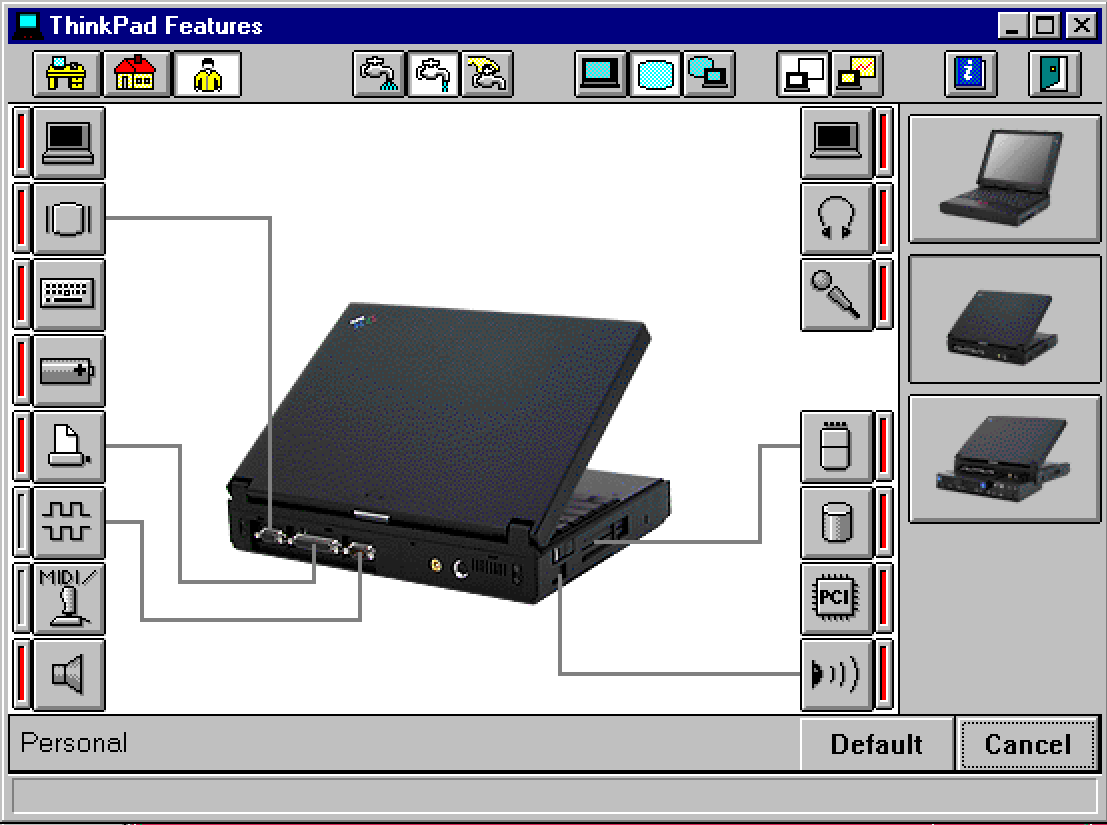
The BIOS on laptops of 97-99 years is extremely limited, you can only set the boot sequence there. All other settings — turning on and off the built-in devices, distributing interrupts — are made in the IBM proprietary utility, which is available in versions for both Windows and DOS. Under Windows, of course it’s more convenient.
In the 90s, Russian users (and not only) formed such a complex combination of love and hate in relation to Windows. Almost everyone used Windows, the alternatives in the form of OS / 2 or even Unix / Linux were extremely rare. At the same time, Windows was an everyday topic of jokes on the subject of instability and glitchiness. My impressions of Windows 95 and 98 stuck in my memory so that it’s hard to figure out where there were more problems and where there was more benefit.
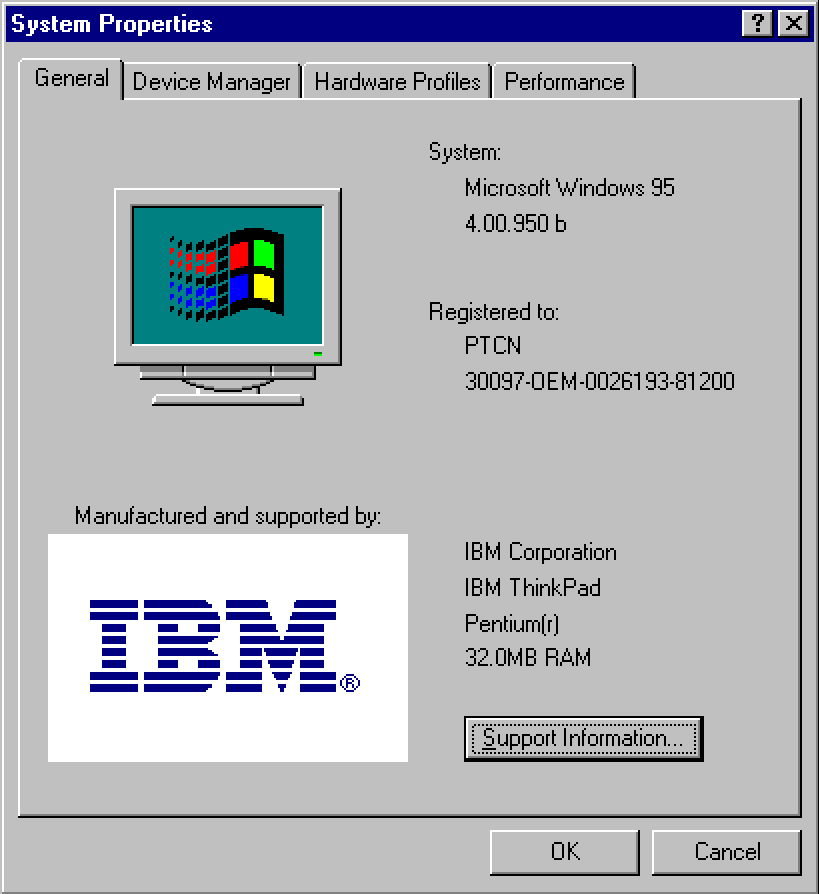
It can be said for certain that Windows 95 was a breakthrough operating system. The previous version, Windows 3.1, for a modern user without experience will be complicated: where what lies and how it starts is not entirely clear. Windows 95 has laid down the user interface concepts used so far: the Start button with the menu of the same name, the control panel, the taskbar with the clock and icons of resident programs. Was it buggy and unreliable? In a sense, yes, it did: partly it was caused by a radical change in technology, the advent of virtual device drivers, and support for long names. Not all software and device driver developers were ready for these innovations. There was a huge array of old programs that might not work correctly in the new environment.
Perhaps the specifics of the Russian market played against Windows: pirated copies installed on computers of incomprehensible origin, assembled from whatever - anything would be buggy in such an atmosphere. Mentally, it was not immediately possible to switch from a keyboard-text DOS interface to a sharpened Windows mouse. And in some places it didn’t work at all - many still use panel file managers. I always regarded Windows 95 as a kind of beta version of Windows 98. It seems that three years after the release of the 95th, we fixed the bugs, added the missing features, and it finally became normal. This is so, but here is another perspective.

Windows 95 in its original version did not even support TCP / IP networks out of the box. This was the moment when the Microsoft leadership seriously miscalculated in its assessments of the prospects for the Internet (in the form in which it exists now). I tried, in my style, to file my own, proprietary Internet in the form of Microsoft Network .

By the release of Windows 98, the error had been fixed, but how: they put the web in places where it would seem that it did not need to be pushed at all. The most famous example is a constantly falling active desktop , in fact a browser instead of desktop wallpaper. In the end, this Windows 98 crashed into a live presentation, not 95 at all:
In this perspective, Windows 95 is not beta 98, it is Microsoft's latest purely offline operating system. You can compare it with Windows 7, which suited everyone, and the 98th - with Windows 8, in which an unjustified bet was made on maximum mobility and sharpening on touch screens. Adjusted for the time, of course: there are simply no many familiar functions in Windows 95, which is why frustration occurs periodically. But I can confirm that on the ThinkPad 380E, a fairly powerful computer that was created specifically for Windows 95, this system works quite stably.
The ThinkPad 380E looks huge even compared to the ThinkPad 600, the more expensive 1998 model. Not to mention modern laptops (on the photo above is the Thinkpad X1 Carbon, and in this context it doesn't even look like a laptop).
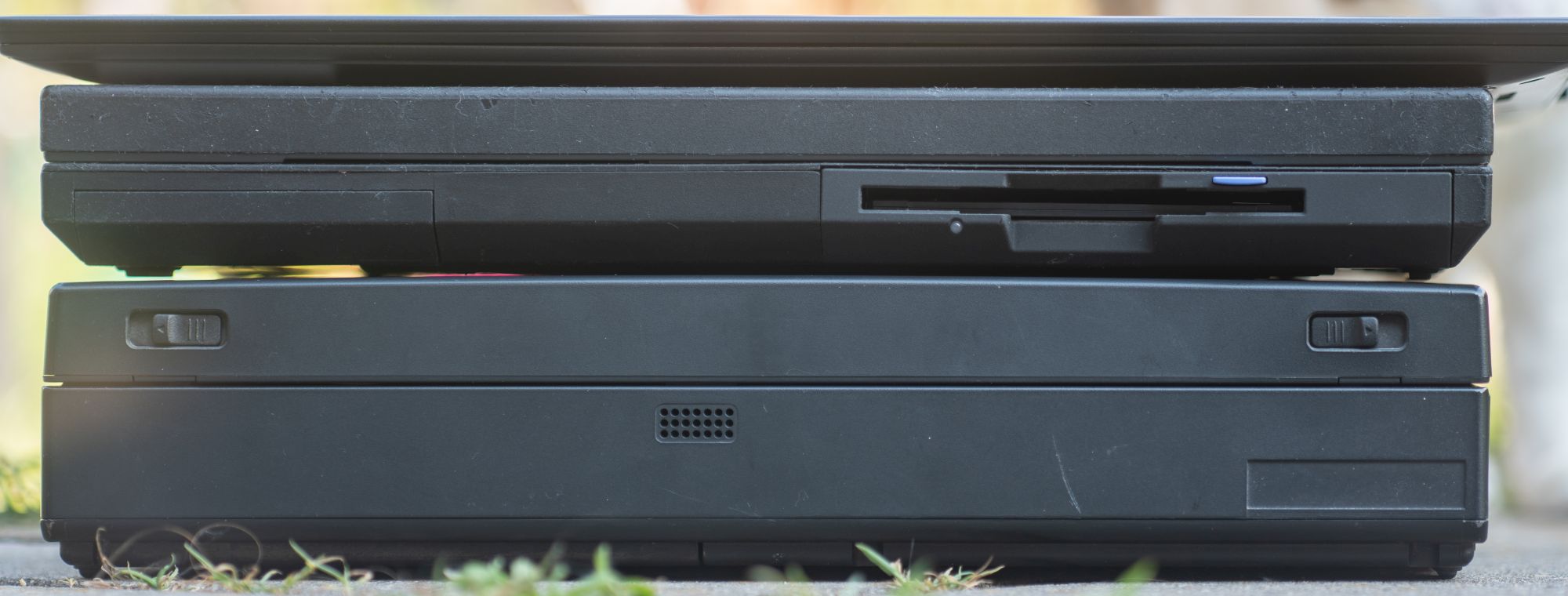
However, the size (6 centimeters of thickness!) And weight do not seem like a serious drawback against a completely budget screen. Almost 10 years ago, I adapted the slightly more advanced ThinkPad 380ED to download torrents by installing Linux on it. I won’t do anything with a budget laptop - let it remain a historically reliable “time capsule”, with original software, desktop wallpapers and proprietary utilities. Unless in time it will be necessary to disassemble it, remove the hard drive and save the image somewhere. With the exception of the hard drive, it seems to me everything else in this laptop is quite reliable and will work for many more years.

In 1997, the ThinkPad 380E was a cool laptop, but one that you still want a more powerful model, thinner and more fashionable. Now, compared to expensive IBM models, it has one important advantage. Due to the economy, the brand-name rubber coating was not applied to the case of the 380th series, which eventually becomes completely unusable. It is possible that the first owner of this inexpensive model made an upgrade, and not so actively used a laptop. This may not be the most outstanding laptop of my collection, but it is definitely the best preserved.

The laptop I’d like to talk about today is the 1997 economy class. Moderately powerful, moderately mobile, but noticeably inferior to the flagships. Last year, I bought the IBM ThinkPad 380E in pristine condition, with a live hard drive and battery. It seems that it has never been opened, and the original Windows 95 with all utilities is still installed there. Let's look at both the laptop and this first truly modern Windows. And we will decide whether its reliability corresponds to all the jokes that were told about it.
I keep a diary of a collector of old pieces of iron in real time in a Telegram . In the next couple of weeks I will share my impressions of one of the first PDAs on Windows CE - Philips Velo 1.
The IBM ThinkPad 380 notebook series was introduced in 1997. In March 1998, the lineup was updated. At least from the point of view of processors, this was a time of great progress. In my own coordinate system, even the Pentium MMX, released in 1996, seemed incredibly powerful, and in May 1997 the Pentium II was introduced, which remained relevant until the beginning of the 2000s. An update to the 1998 IBM notebook line, however, still uses Pentium MMX mobile processors with a frequency of 200 or 233 megahertz. But today we have a post of

Laptops were expensive. This is an ad from PC Magazine in November 1997. Most attention is paid to the ThinkPad 380ED laptop, which started my vintage notebook hobby many years ago . In the footnote you can see the specifications and price of the hero of this article.

The specifications on my laptop are fully consistent with the advertising ones:
Processor : Intel Pentium MMX 150 MHz
Memory : 16 megabytes EDO SDRAM (later I increased the volume to 32 megabytes, maximum 64)
Hard disk : 2.1 gigabytes
Display : 12 inches, 800x600 pixels, technology FRSTN, 65k colors
Video card : Neomagic Magicgraph 128ZV, 1,125 megabytes of internal memory
Connectors and communication : IrDA 1.1, PCMCIA 16 bit, serial and parallel ports, VGA, port replicator
Battery : NiMH, up to two hours of battery life
Dimensions and weight: 300x233x60 mm 3 kilograms

Such a laptop in the United States cost $ 2,099, or $ 3,342, adjusted for inflation. A small upgrade that adds a CD-ROM drive and a more powerful processor to the laptop will cost $ 500. But the top-end device of the series - 380ED with a TFT matrix and a five-gigabyte hard drive - will cost $ 4,000 already (6,367 adjusted for inflation). In 2019, you can buy a very good laptop for 2-3 thousand dollars, but in those days only the budget option was available for that kind of money. Do not forget that the ThinkPad 3xx series generally consisted of entry-level portable computers. Prices for thinner fifth-series laptops and 7xx desktop substitutes were even higher: the same advertisement mentions the ThinkPad 760XD with an entry-level config for $ 4,700 (7,500 modern).

I wonder where they first came up with this 3-5-7 digital sequence to separate budget, normal and premium devices? In a BMW? Below $ 2,000, one could fall only due to an even greater deterioration in performance, or if you look towards lesser-known brands. In 1998, IBM will release a ThinkPad 310E laptop with a starting price of 1600. It will not differ much from the hero of the post, only the screen will be even worse, although it would seem to be much worse?
When the screens were terrible
What can I say, it's easier to show the video.
In a review of the ThinkPad X301, the flagship of 2008, I already complained: it seems to be a good laptop and relatively suitable for modern tasks, but the display. Today we are completely spoiled by IPS-screens with huge viewing angles, and we look askance at ordinary TFTs: it is worth turning the screen a little differently, and colors begin to immediately distort. In 1997, the choice was between the newfangled and expensive TFT and cheaper displays with Super-twisted nematic technology . According to STN technology, black-and-white screens of the first laptops were made, then color ones appeared. From the usual TFT-screens (in those days they were called “active matrices”, denoting the ability to individually control the on and off of each pixel), they were distinguished by extremely high response time, low contrast and a small working viewing angle.

The ThinkPad 380E's laptop display is made using Fast Response STN technology, but this Fast translates to a passport response time of 150 milliseconds (versus 75ms in the first TFT screens). Contrast ratio is 35 to 1 (against 100 to 1 in TFT displays of the past and 1000: 1 in modern ones). Identifying a vintage laptop with a CSTN display is usually possible by the presence of two controls: in addition to the usual brightness of the display, you can adjust the contrast. The 380E does not comply with this rule: brightness is not adjustable at all, and a single slider controls contrast. This is an important regulator, it allows you to adjust the display from the state "nothing is visible at all" to "something can be read, but with difficulty." To be honest, neither color rendition nor response time cause me problems when working with a laptop. But the viewing angles are just awful.

Budget laptop in perspective
Why was a laptop needed in the late nineties? In a January 1998 PC Magazine editorial , magazine editor Michael Miller unambiguously defines the target audience: frequently traveling professionals who need access to the Internet, access to a large amount of data and the ability to work with them at any time. Only in passing is a category of people mentioned who carry a laptop only to and from work. A situation has not yet been formed in which it is easier to give a laptop to a new employee than to install a desktop with a monitor and wires. I do not think that the computer was then laid down, as it is now, in general to all employees up to the guard and secretary. Even budget models were not accessible to everyone: in 1998, I saw laptops except on store shelves and in the movies.

The 380E lacks the main element of an employee conducting a business trip for six months - the built-in modem. In general, this is the only device in my collection that I encountered with certain difficulties: I have no optical drive, no USB (it will appear a year later), how do I upload large volumes of data to it? On floppy disks? The modem, however, is added without problems by installing a PCMCIA expansion card, in the same way you can connect the laptop to a local network or add a USB flash drive. This laptop does not understand 32-bit PCMCIA cards, but I have in stock a couple of suitable old adapters. But in general, since we have before us such an intentionally limited device, it will be interesting to emulate a modem connection via a serial port.

Devices on Pentium II and higher can still be tried to somehow attract to modernity, but here the situation is different - why, what's the point? I did not even make out this museum exhibit and began to study the installed software.

The BIOS on laptops of 97-99 years is extremely limited, you can only set the boot sequence there. All other settings — turning on and off the built-in devices, distributing interrupts — are made in the IBM proprietary utility, which is available in versions for both Windows and DOS. Under Windows, of course it’s more convenient.
Windows 95 Modern Assessment
In the 90s, Russian users (and not only) formed such a complex combination of love and hate in relation to Windows. Almost everyone used Windows, the alternatives in the form of OS / 2 or even Unix / Linux were extremely rare. At the same time, Windows was an everyday topic of jokes on the subject of instability and glitchiness. My impressions of Windows 95 and 98 stuck in my memory so that it’s hard to figure out where there were more problems and where there was more benefit.

It can be said for certain that Windows 95 was a breakthrough operating system. The previous version, Windows 3.1, for a modern user without experience will be complicated: where what lies and how it starts is not entirely clear. Windows 95 has laid down the user interface concepts used so far: the Start button with the menu of the same name, the control panel, the taskbar with the clock and icons of resident programs. Was it buggy and unreliable? In a sense, yes, it did: partly it was caused by a radical change in technology, the advent of virtual device drivers, and support for long names. Not all software and device driver developers were ready for these innovations. There was a huge array of old programs that might not work correctly in the new environment.
Perhaps the specifics of the Russian market played against Windows: pirated copies installed on computers of incomprehensible origin, assembled from whatever - anything would be buggy in such an atmosphere. Mentally, it was not immediately possible to switch from a keyboard-text DOS interface to a sharpened Windows mouse. And in some places it didn’t work at all - many still use panel file managers. I always regarded Windows 95 as a kind of beta version of Windows 98. It seems that three years after the release of the 95th, we fixed the bugs, added the missing features, and it finally became normal. This is so, but here is another perspective.

Windows 95 in its original version did not even support TCP / IP networks out of the box. This was the moment when the Microsoft leadership seriously miscalculated in its assessments of the prospects for the Internet (in the form in which it exists now). I tried, in my style, to file my own, proprietary Internet in the form of Microsoft Network .

By the release of Windows 98, the error had been fixed, but how: they put the web in places where it would seem that it did not need to be pushed at all. The most famous example is a constantly falling active desktop , in fact a browser instead of desktop wallpaper. In the end, this Windows 98 crashed into a live presentation, not 95 at all:
In this perspective, Windows 95 is not beta 98, it is Microsoft's latest purely offline operating system. You can compare it with Windows 7, which suited everyone, and the 98th - with Windows 8, in which an unjustified bet was made on maximum mobility and sharpening on touch screens. Adjusted for the time, of course: there are simply no many familiar functions in Windows 95, which is why frustration occurs periodically. But I can confirm that on the ThinkPad 380E, a fairly powerful computer that was created specifically for Windows 95, this system works quite stably.
Miracle Chest
The ThinkPad 380E looks huge even compared to the ThinkPad 600, the more expensive 1998 model. Not to mention modern laptops (on the photo above is the Thinkpad X1 Carbon, and in this context it doesn't even look like a laptop).

However, the size (6 centimeters of thickness!) And weight do not seem like a serious drawback against a completely budget screen. Almost 10 years ago, I adapted the slightly more advanced ThinkPad 380ED to download torrents by installing Linux on it. I won’t do anything with a budget laptop - let it remain a historically reliable “time capsule”, with original software, desktop wallpapers and proprietary utilities. Unless in time it will be necessary to disassemble it, remove the hard drive and save the image somewhere. With the exception of the hard drive, it seems to me everything else in this laptop is quite reliable and will work for many more years.

In 1997, the ThinkPad 380E was a cool laptop, but one that you still want a more powerful model, thinner and more fashionable. Now, compared to expensive IBM models, it has one important advantage. Due to the economy, the brand-name rubber coating was not applied to the case of the 380th series, which eventually becomes completely unusable. It is possible that the first owner of this inexpensive model made an upgrade, and not so actively used a laptop. This may not be the most outstanding laptop of my collection, but it is definitely the best preserved.
